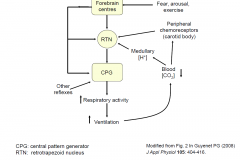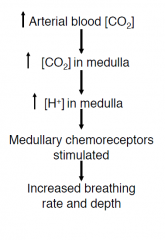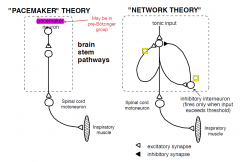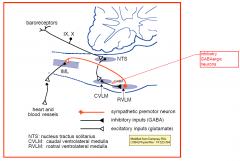![]()
![]()
![]()
Use LEFT and RIGHT arrow keys to navigate between flashcards;
Use UP and DOWN arrow keys to flip the card;
H to show hint;
A reads text to speech;
15 Cards in this Set
- Front
- Back
|
Medulla Functions
|

- contains tracts
- REGULATES: 1. breathing 2. BP 3. others (swallowing, vomitting) |
|
|
Pons
|
- contains tracts
- relays signals from cerebellum to the forebrain - also important in breathing regulation |
|
|
What central mechanisms generate respiratory rhythm?
|

basic respitratory rhythm via RESPIRATORY CENTRE
- INSPIRATION: inc. firing rate - rate and depth regulated by inputs from 1. PCO2, pH, PO2 via resp. centre 2. Afferents from lungs 3. Inputs from higher brain centres (eg motor cortex) |
|
|
Where is the CO2 level sensed and how does it drive breathing?
|

- medullary chemoreceptors (currently thought to be in the retrotrapezoid nucleus (RTN) in caudal pons/rostral medulla
- INC. CO2 v.powerful stimulus to breathing |
|
|
Where is the blood O2 level sensed and how does it drive
breathing? |
Peripheral Chemoreceptors
- in the carotid body that respond to levels of O2 in the blood (also in arotic bodies) - via CN IX |
|
|
Breathing increases during exercise, fear or arousal. What mechanisms cause that?
|
Forebrain centre feeds onto RTN
|
|
|
The pattern of breathing (i.e. duration of inspiration) is reflexly affected by afferent inputs from lungs. What are the receptors and reflex pathways?
|
Hering-Breuer reflex
- Pulmonary stretch receptors in the bronchi & bronchioles that are excited when the lungs inflate - this messages travels to resp. centre inthe brainstem via vagus and cause inhibition of inspiration via pneumotaxic centre - thus limits inspiration and reduce the depth of breathing and increases its rate - protective against lung overinflation and also min. work - there are also inputs from the receptors in the chest wall that play a role in min. resp. work |
|
|
EMG of diaphragm
|

|
|
|
Respiratory Centres in Brainstem
|
- Dorsal Respiratory Group DRG: consist mainly inspiratory neurons
- Ventral Respiratory Group VRG: both inspiratory and expiratory neurons - Pneumotaxic Centre (PONS): inhibit inspiratory neurons, thus limit inspiration - Apneustic centre (PONS): excite inspiratory neurons - INSPIRATORY neurons many descend spinal cord to control motoneurons to inspiratory muscles - EXPIRATION is a passive process but some neuroms also descend to drive expiration |
|
|
2 theories for Respiratory Rhythmogenesis
|

1. pacemaker theory
2. Network theory |
|
|
BP regulation (rat)
|
NA: vagal preganglionic regulates HR
RVLM (rostral ventrolateral medulla): regulating sympathetic outflow to heart, blood vessels, adrenal medulla NTS: BP and breathing; termination site of inputs for a whole range of receptor, IX and X afferent fibres from visceral receptors in CV system, lungs, gut etc (e.g. from baroreceptors, chemoreceptors and lung inflation receptors) Area Postrema: lacks BBB so circulating substances (eg AngII act directly here) |
|
|
RVLM neurons
|
• project directly to sympathetic preganglionic neurons in spinal cord
• are tonically active, and this tonic activity maintains resting sympathetic activity and hence resting blood pressure • receive inputs (excitatory and inhibitory) from a wide range of peripheral receptors and from cardiovascular nuclei in the pons, midbrain, and forebrain • are a critical component of baroreceptor and other cardiovascular reflex pathways, as well as pathways mediating cardiovascular responses from higher centres |
|
|
How is BP to different areas of the body regulated?
|

Premotor sympathetic neurons in RVLM consist of subgroups that regulate specific vascular beds
|
|
|
Reflexes for cardiovascular Challenges
|

Cardiovascular challenges evoke reflex changes in sympathetic nerve activity which tends to restore homeostasis
DEPENDS on baroreceptors and RVLM |
|
|
Baroreceptors Reflex
|

- via DISINHIBTION
|

